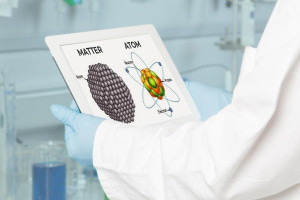This beginner series in chemistry delves into the world of matter, elements and compounds, as well as their structures. This course explores the elements created from a single atom, like neon gas, or from a combination of two or more identical atoms. We also study various compounds and their structure. You'll begin by learning the three states of matter (solid, liquid and gas) and their different qualities. You will become familiar with the kinetic theory of gases and the ideal gas equation, PV = nRT, used to determine any gas's unknown characteristics, including the relative molecular mass of simple molecules. Following that, you will explore the transformation of a solid into a liquid and vice versa related to high and low temperatures. You'll also discover the crystal lattices and their diverse types, including ionic, metallic and covalent, along with studying the solid state.
The following section discusses the structure of an atom, including its protons, neutrons and electrons. You will discover what the atomic number (Z) and the nucleon number, also called ‘mass number’ (A), are. After that, you'll learn about the Periodic Table, which contains elements arranged according to their atomic number in 7 periods and 18 groups. We will research all the elements that possess the same atomic number but have varying numbers of neutrons, known as ‘isotopes’, and their assorted characteristics. We will examine the two types of ions: cations with a positive charge and anions with additional electrons that form a negative charge.
The course then discusses orbitals, subshells (s, p, d, and f), and the shells that electrons inhabit around the nucleus. You'll discover that every subshell has a minimum of 2 and a maximum of 14 orbitals. Research electronic configuration, a building-up mechanism that adds electrons to orbitals, from lowest to the greatest in energy. Finally, you will investigate ionisation energies and how they vary through periods and groups, impacted by factors such as the distance between electrons and nuclear charge, the growth in atomic number and the shielding of the inner shell to the outer electrons. Don't delay. Start learning Chemistry today with the first course in this ‘Beginner Chemistry’ series.
What You Will Learn In This Free Course
View All Learning Outcomes View Less All Alison courses are free to enrol, study, and complete. To successfully complete this Certificate course and become an Alison Graduate, you need to achieve 80% or higher in each course assessment.
Once you have completed this Certificate course, you have the option to acquire an official Certificate, which is a great way to share your achievement with the world.
Your Alison certificate is:
- Ideal for sharing with potential employers.
- Great for your CV, professional social media profiles, and job applications.
- An indication of your commitment to continuously learn, upskill, and achieve high results.
- An incentive for you to continue empowering yourself through lifelong learning.
Alison offers 2 types of Certificate for completed Certificate courses:
- Digital Certificate: a downloadable Certificate in PDF format immediately available to you when you complete your purchase.
- Physical Certificate: a physical version of your officially branded and security-marked Certificate
All Certificate are available to purchase through the Alison Shop. For more information on purchasing Alison Certificate, please visit our FAQs. If you decide not to purchase your Alison Certificate, you can still demonstrate your achievement by sharing your Learner Record or Learner Achievement Verification, both of which are accessible from your Account Settings.











 Avg. Hours
Avg. Hours  Contains Video
Contains Video  CPD Accredited
CPD Accredited 
 Total XP:
Total XP: 
 Knowledge & Skills You Will Learn
Knowledge & Skills You Will Learn 







